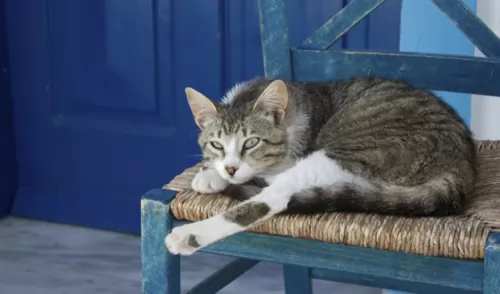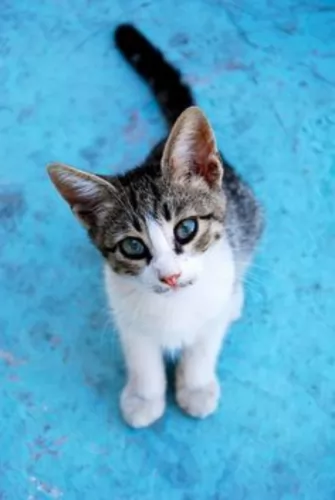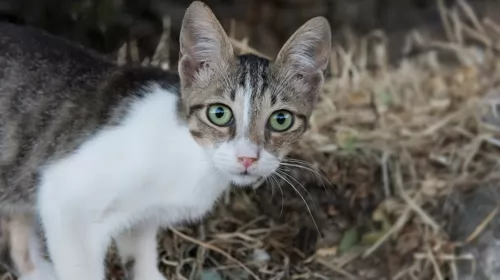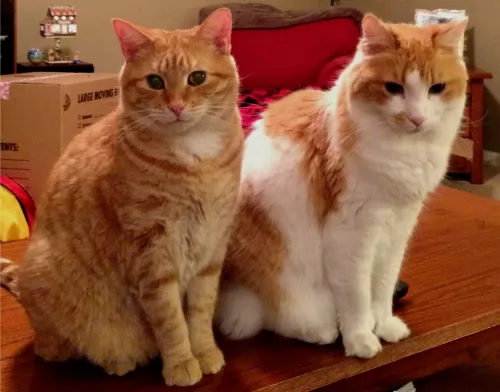 Petzlover
Petzlover Aegean is originated from Greece but Bicolor is originated from United States. Both Aegean and Bicolor are having almost same weight. Aegean may live 5 years less than Bicolor. Both Aegean and Bicolor has same litter size. Both Aegean and Bicolor requires Moderate Maintenance.
Aegean is originated from Greece but Bicolor is originated from United States. Both Aegean and Bicolor are having almost same weight. Aegean may live 5 years less than Bicolor. Both Aegean and Bicolor has same litter size. Both Aegean and Bicolor requires Moderate Maintenance.
 Thought to be the only native Greek variety of cat, the attractive Aegean cats hails from Greece – more specifically the Cycladic Islands of Greece.
Thought to be the only native Greek variety of cat, the attractive Aegean cats hails from Greece – more specifically the Cycladic Islands of Greece.
Formal breeding of the cat started in the 1990s but the cat isn’t recognized by any of the top cat breeding organizations. These cats are believed to be one of the oldest domesticated cat breeds, and in Greece are considered a national treasure.
 The first thing to know is that a Bicolor cat isn’t in fact a breed. Bicolor is just a term that describes a certain look that a cat has with its coat. It’s a cat with two colors such as red and white or black and white.
The first thing to know is that a Bicolor cat isn’t in fact a breed. Bicolor is just a term that describes a certain look that a cat has with its coat. It’s a cat with two colors such as red and white or black and white.
A popular name for bi-color cats is also Piebald or Tuxedo, and in fact many cat breeds can produce bicolor kittens, or black and white kittens such as Cornish Rex, Maine Coon, Manx, and others.
There are different coat color combinations when it comes to bicolor cats and the black and white markings may be more common but there are other color combinations too such as orange and white.
Nobody seems to know the origins of the Bicolor cats so we are going to assume they come from the USA.
 Aegean cats are a nice athletic, medium-sized cat with fairly longish hair and weighing in the region of 4.5 – 5 kg and standing in height at between 21 and 25,4cm.
Aegean cats are a nice athletic, medium-sized cat with fairly longish hair and weighing in the region of 4.5 – 5 kg and standing in height at between 21 and 25,4cm.
The cat sheds during the spring and summer, but if they are essentially indoor cats they will shed all year.
The coat can be made up of two or three colors with white always as one of the main colors and taking up more space on the coat than other colors. Other colors in all their different patterns can be grey, orange or black.
The tail of the cat is long and bushy the ears are quite large and wide at the base and are then gently rounded at the top. The head is broad, the eyes are almond-shaped and can be anything from green to blue or yellow.
These cats are strange in that they quite enjoy being around water, fascinated by the movements below the water’s surface. They’re also social cats, love being around their human family and also around children in the home.
If you have a hobby such as fishing you can take this breed of cat with. In fact, they love the outdoors and if you go out hiking or fishing, they’ll be there, climbing and exploring with you. These attractive cats are known to make awesome family pets, having been domesticated for centuries. Full of energy, they are also quite vocal.
 Regardless of the breed they belong to, information on these cats suggests that they can have many different looks. Look at the amazing Turkish Van cat for instance – each of these cats is recognizable for its long, luxurious fur. You’ll find a few touches of color on the cat's ears and tail, making in a Bicolor. They also have an interesting characteristic – being fond of water!
Regardless of the breed they belong to, information on these cats suggests that they can have many different looks. Look at the amazing Turkish Van cat for instance – each of these cats is recognizable for its long, luxurious fur. You’ll find a few touches of color on the cat's ears and tail, making in a Bicolor. They also have an interesting characteristic – being fond of water!
These Bicolor cats weigh in the region of 3 – 7kg, and can tend towards the smaller or larger size. Some of them can have short or long hair, larger or smaller ears and green or yellow eyes.
Coming from different cat breeds, the bicolor cat can have a mix of wonderful characteristics – they can be vocal or quiet or confident or shy.
They’re always wonderful though and can be curious, intelligent, playful, loving and loyal. They make great companions who just love the interaction they have with their human owners.
 The Aegean is friendly, loving and social and he will get on well with children and animals in the home.
The Aegean is friendly, loving and social and he will get on well with children and animals in the home.
He is intelligent and will try to talk to you, even if it's to invite you to go swimming with him, as he is an unusual cat with his love of water.
Bringing such a cat into your home and heart will promise to bring you years of wonderful companionship.
 The Bicolor cat is such a steady, reliable cat-friend to have. When you start looking as these cats as your companion, you're going to get a smart, funny, adoring, playful family member who will be there for you whether you go to work each day or stay at home.
The Bicolor cat is such a steady, reliable cat-friend to have. When you start looking as these cats as your companion, you're going to get a smart, funny, adoring, playful family member who will be there for you whether you go to work each day or stay at home.
They’re such easygoing cats, with no airs and graces. They’re happy, relaxed, and uncomplicated cats and when you make a Bicolor your pet and friend, your life just becomes that much more meaningful.
 By providing your kitty cat with a loving home, you can ensure that he stays as healthy as possible. Unfortunately though, cats can get sick, regardless of how well you take care of them and then as a responsible pet owner, you will be able to take your pet to your local vet.
By providing your kitty cat with a loving home, you can ensure that he stays as healthy as possible. Unfortunately though, cats can get sick, regardless of how well you take care of them and then as a responsible pet owner, you will be able to take your pet to your local vet.
Some of the common cat problems you get can be kidney disease, ear infections, dental disease, parasites such as heartworm, cancer or something like feline immunodeficiency virus.
Whether your cat has a virus or an infection, remember that getting your cat to the vet can mean nipping the problem in the bud before it gets more serious.
 Once you bring a kitten into your home, or any pet for that matter, get to know where your closest vet is. This is so you know where to go if your pet becomes ill, he requires his first vaccines or there is a medical emergency where he needs to see someone immediately.
Once you bring a kitten into your home, or any pet for that matter, get to know where your closest vet is. This is so you know where to go if your pet becomes ill, he requires his first vaccines or there is a medical emergency where he needs to see someone immediately.
When you buy food for your cat, try and buy high-quality food. Speak to your vet if you aren’t sure how to feed your cat. Cats require taurine, which is an essential amino acid needed for healthy hearts. Always make sure your cat has fresh, cool water at all times.
Every cat, whether short- or long-haired will require some combing and brushing to get rid of those loose hairs. The Aegean cat is a moderate shedder. Not only that, if you start with this grooming when your cat is a kitten, he will look forward to it and it will strengthen the bond between you.
Both fleas and ticks can be found on cats, and controlling these kinds of parasites requires speaking to your vet for something that can get rid of them. The vet will recommend products, and a flea and tick collar can also be useful but they will need to be renewed quite frequently.
Your Aegean kitten will need vaccinations to protect him from life-threatening diseases such as Feline Leukaemia Virus, Feline Infectious Enteritis and Cat flu. The first vaccines will be required at 8 weeks of age.
Sometimes it may be necessary to also have your pet vaccinated against rabies, depending on where you live. Throughout your cat’s life, to maintain his immunity, regular booster shots will be required.
 Caring for your Bicolor cat is much the same as with any other cat. Your Bicolor will shed, so brushing him will tickle him pink, especially if you do it lovingly and gently – it’s like a bonding session. The weekly brushing will get rid of loose hairs and dust and keep the coat healthy and shiny.
Caring for your Bicolor cat is much the same as with any other cat. Your Bicolor will shed, so brushing him will tickle him pink, especially if you do it lovingly and gently – it’s like a bonding session. The weekly brushing will get rid of loose hairs and dust and keep the coat healthy and shiny.
Spay or neuter your pet to avoid unwanted kittens. Stay up to date on veterinary visits and vaccinations.
Provide your cat with stimulating toys as well as all the equipment he needs to be comfortable – food and water bowls, litter box, grooming equipment, bedding, climbing- and scratching equipment.
All cat owners, whether their cats eat homemade food or wet- or dry food should read cat food labels and understand the nutrients content.
Certainly, as a carnivore, cats require certain vitamins, minerals, and proteins that only meat can provide.
Understand how to work out if the cat food is balanced or not and not packed with too many grains and carbohydrates.
How much your Bicolor eats will depend on his age and his activity levels. Be careful not to overfeed your cat as overfeeding is dangerous. When cats put on too much weight, it leads to problems such as diabetes, heart- and joint disease.